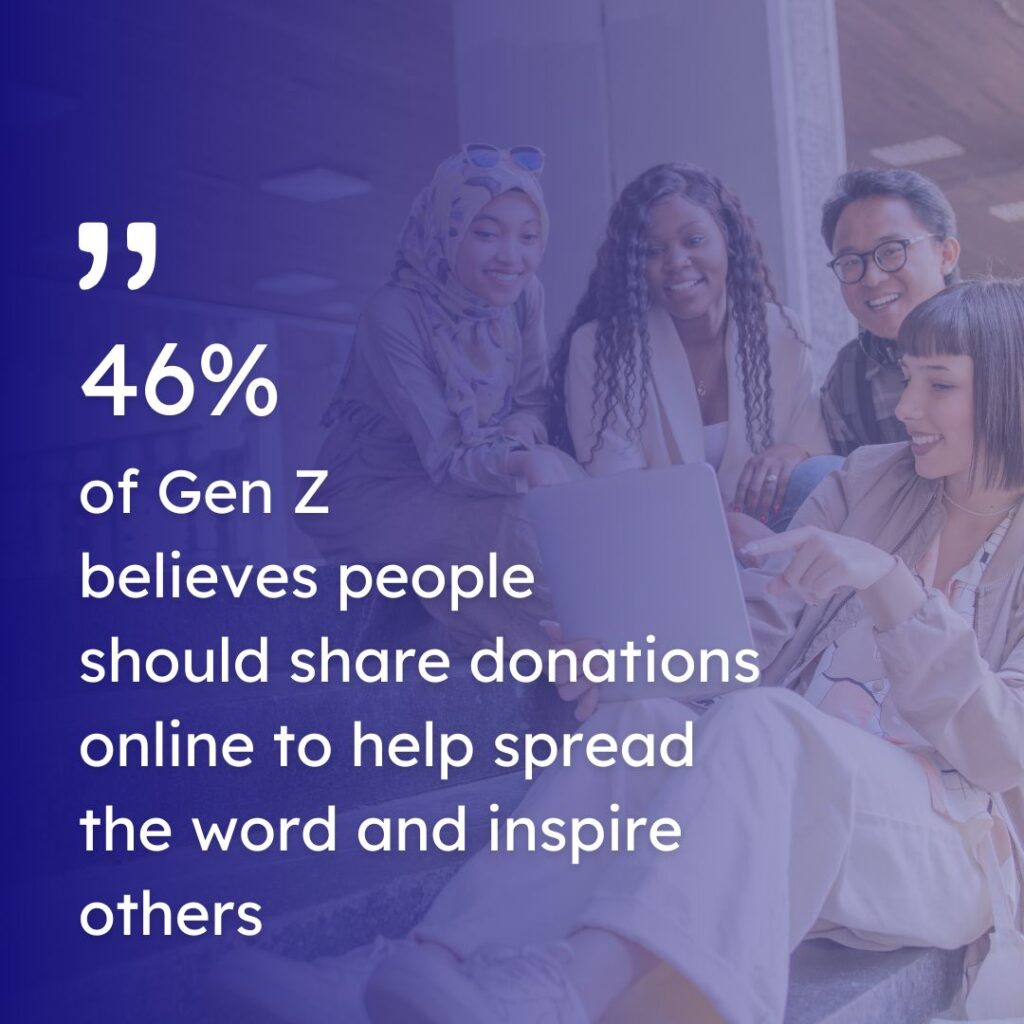Gen Z: Surprising Ways They are Transforming Fundraising

This blog post is based on podcast episode. Listen now: Gen Z and Social Giving: Unlocking Nonprofit Success Through Social Media and AI
They may be young, but Gen Z is dramatically changing the shape of nonprofit fundraising.
This dynamic and socially conscious group of young people is the largest and most diverse generation in U.S. history, and they are establishing their giving practices, with more than half budgeting to donate to causes annually.
Gen Z, with their unparalleled digital fluency and passion for social causes, is leveraging these skills to create meaningful impact and change. This is why Gen Z, mostly in their early 20s, is emerging as a driving force behind nonprofit success.
Tech-savvy Gen Z, having grown up on social media, is not shy about promoting the causes they believe in or telling others about their donations. Their sharing behavior is 10 times more likely to drive donations on social media than Baby Boomers, making it a crucial aspect for nonprofits to harness.
Why does social sharing matter? Sharing drives more donations. It’s a total shift in behavior that nonprofits should harness to boost their fundraising efforts, grow their donor bases, and raise brand and issue awareness.
Gen Z, on track to become the wealthiest generation, is estimated to reach a staggering 12 trillion in spending within the next five years, overtaking Baby Boomers. They are reshaping the giving landscape and using digital tools like integrations with Meta platforms to make donating easier than ever.
What is the State of Social Giving Report?
The State of Social Giving Report is an in-depth analysis of online and social media-driven donation trends, highlighting the behaviors, motivations, and impact of different donor demographics. It examined 1,000 individuals, with particular attention paid to the impact of Gen Z — those born between 1997 and 2012 — on the nonprofit sector.
With their reliance on social media, peer-to-peer sharing, and creative fundraising campaigns, Gen Z is donating and rallying their networks to support causes they care about.
The Role of Gen Z in Nonprofit Fundraising
Gen Z has redefined traditional giving methods. For example, 46 percent believe people should share donations online to help spread the word and inspire others. Research shows that every time an organizer shares their fundraiser, it can help drive an additional $100 on average toward their goal.

Half of Gen Z shares causes or fundraisers at least once a week. Half of Millennials and Gen X are also sharing, but only monthly. This level of advocacy continues to drop with older generations, with 88% of Boomers occasionally, rarely, or never sharing.
Some of the most common reasons why Gen Z shares causes and fundraisers:
- 42% want to feel more directly connected with the solution
- 36% believe sharing plays a role in the community
- 36% want to get more support for a cause they care about
- 32% want to influence others to give
Sharing not only drives more dollars but also inspires others to give. The report found that 41% of Gen Z said social media content had motivated them to research or donate to a cause. This trend extends across generations, too. Nearly a quarter of Millennials and 20% of Gen X are also motivated by what they see on social media.
Start connecting with Gen Z today and watch your campaigns thrive!
What Drives Gen Z to Give?
- Digital-First Mindset:
- These digital natives spend an average of four hours daily on social media platforms, making digital outreach critical for nonprofits.
- They prefer engaging with causes through Instagram, TikTok, and other platforms where visual storytelling thrives.
- Advocacy and Awareness:
- Beyond donating, Gen Z prioritizes spreading awareness, often sharing campaigns with their networks to amplify reach.
- For example, a single viral TikTok video about a nonprofit can generate thousands of views, donations, and new followers overnight.
- Authenticity Matters:
- Gen Z values transparency and authenticity. They’re more likely to support organizations that communicate their mission, impact, and use of funds.
- Micro-Giving Adds Up:
- While individual donations may be smaller, Gen Z’s collective efforts often result in significant fundraising outcomes.
- Crowdfunding and peer-to-peer campaigns resonate strongly, allowing supporters to rally friends and family to contribute.
Impact Creators: The New Fundraising Champions
Gen Z (and Millennials) are also more likely to follow the impact creators — individuals who use their social platforms to champion causes, raise funds, and inspire others to act. These creators can be everyday people, influencers, or nonprofit advocates who:
- Use personal stories and experiences to connect with audiences.
- Host live fundraising events on platforms like Instagram or Facebook.
- Encourage their followers to donate by setting fundraising challenges or milestones.
We’re not talking about celebrities. Impact creators are often people who may already be within your nonprofit network. They could be board members, volunteers, or program participants. These content creators use their platforms for good, often raising awareness and money to drive support where needed. And they have had great success reaching younger donors.
Impact creators are often people with 10,000 followers or less, so their influence is localized and viewed as authentic and trustworthy. Think moms who support children with disabilities or people impacted by the opioid crisis — they hold sway with like-minded supporters who are likely to become new donors.
One in four Gen Z say they have been motivated to donate because of an impact creator they follow, and half would trust that creator to donate on their behalf. That’s right. These young donors trust the impact creators enough to send the donation wherever they see fit, something we haven’t seen in most older donors.
Impact Creators in Action
- Influencers with a Cause:
- Influencers on platforms like TikTok and Instagram often use their large followings to support nonprofit campaigns. For example, an environmental influencer might create a campaign urging their followers to donate to a reforestation project, sharing before-and-after photos of impacted areas to demonstrate the importance of the cause.
- Grassroots Advocates:
- Individuals can also become impact creators. A student passionate about animal rights might start a fundraiser for a local shelter, posting regular updates and stories about the animals in their care.
- Live Streaming Events:
- Gamers and content creators on platforms like Twitch or YouTube have successfully hosted charity live streams, where viewers donate in real-time while engaging with their favorite creators. For instance, a gamer could organize a 24-hour marathon with donation goals tied to in-game milestones.
- Campaign Challenges:
- Impact creators often use challenges to engage their audience. For example, a fitness influencer might pledge to run a mile for every $100 raised for a health-related nonprofit, inspiring their followers to contribute while watching the journey unfold.
In addition to supporting causes, these creators have also found a place in helping to raise awareness, support, and money during disasters. They can quickly pivot to share information and highlight organizations you can support to help with relief efforts. If you’re a nonprofit, it’s worth learning who the impact creators are in your community or region already supporting your causes.
Want weekly fundraising tips straight to your inbox?
How They’re Changing the Landscape
- Amplifying Reach: By tapping into their established networks, impact creators introduce nonprofits to new audiences, many of whom may not have engaged with the cause otherwise.
- Humanizing Campaigns: Their authentic, personal approach resonates with followers, making campaigns feel more relatable and urgent.
- Sparking Viral Movements: Creative and engaging campaigns have the potential to go viral, generating exponential awareness and donations.
- Fostering Community: Impact creators often cultivate community among their followers, turning supporters into long-term advocates for the cause.
Why Social Giving is So Effective
The combination of Gen Z’s social media savvy and platforms like Classy and Meta have unlocked new levels of fundraising potential. Here’s why social giving works:
- Reach:
- Social platforms provide access to millions of potential donors worldwide, making it easier to scale campaigns quickly.
- Engagement:
- Visual content and interactive features like polls, live videos, and stories keep supporters engaged and invested.
- Social Proof:
- Seeing friends and family donate inspires others to follow suit, creating a ripple effect of generosity.
- Community Building:
- Social giving fosters community among supporters, strengthening connections and increasing donor loyalty.
- Convenience:
- Tools like Classy’s Meta integrations simplify the donation process, ensuring every click counts.
Six Tips to Engage Gen Z in Social Giving Campaigns
To make the most of Gen Z’s enthusiasm and influence, nonprofits should:
- Prioritize Storytelling:
Use compelling visuals and narratives to highlight your mission and impact.
Share testimonials, behind-the-scenes moments, and updates to keep supporters informed and inspired. - Leverage Short-Form Video:
Platforms like TikTok and Instagram Reels are perfect for highlighting your cause in a fun, engaging way. - Partner with Impact Creators:
Collaborate with influencers or passionate supporters who align with your values to amplify your reach. - Make It Easy to Donate:
Use tools like Classy’s Meta integrations to reduce barriers and streamline the donation process. - Encourage Peer-to-Peer Fundraising:
Empower your supporters to create individual campaigns and invite their networks to contribute. - Be Transparent:
Communicate how donations will be used and share the outcomes of your campaigns to build trust and loyalty.
The latest State of Social Giving Report underscores Gen Z’s transformative power in nonprofit fundraising. By embracing social media, partnering with impact creators, and leveraging tools like Classy’s integrations with Meta platforms, nonprofits can engage this passionate generation and drive meaningful change.
Nonprofit leaders can also learn from some of the sector’s most innovative minds by attending the upcoming Collaborative presented by Classy by GoFundMe. This interactive and inspiring event is your chance to expand your network while exploring the future of fundraising.
Ready to harness the potential of social giving? Start connecting with Gen Z today and watch your campaigns thrive!
This blog post is based on a recent episode of the Go Beyond Fundraising podcast. Listen to the complete episode now: Gen Z and Social Giving: Unlocking Nonprofit Success Through Social Media and AI